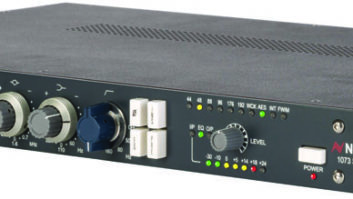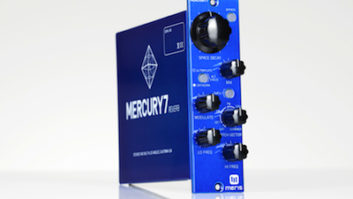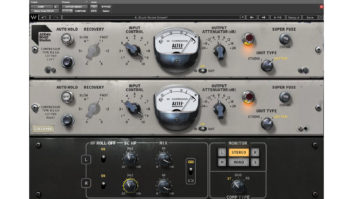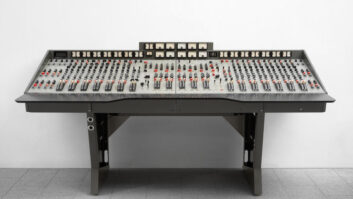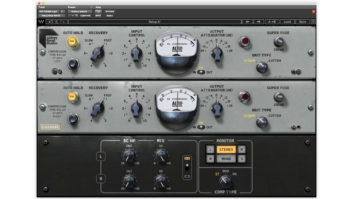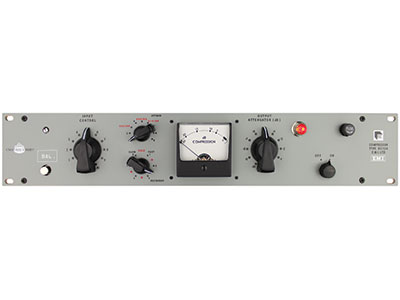
In the early days of recording, it wasn’t uncommon for studios to either make or mod their gear. Abbey Road, for example, purchased several Altec 436B compressors and the studio’s Head of Technical, Bill Livy, Deputy Head Len Page, and EMI Audio Designer Mike Bachelor brought them up to their specs and preferences. The units were altered so much that they renamed them. Thus the original, and EMI-exclusive RS124 was brought to life and used on iconic records from the Beatles and many others.
Wade Goeke, owner and chief designer at Chandler Limited, worked in collaboration with Abbey Road, receiving technical info on the original mods and then re-creating this classic. I tested a pair of RS124s over some sessions at Blackbird Studio in Nashville.
HOW IT WORKS
The RS124 is two-rackspaces tall and, like the original, is simple in design. The controls include two large chicken-head knobs for Input and Output gain, and two smaller knobs for Attack and Recovery. Also on the front are an on/off switch, large gain reduction meter and a “Bal” button that re-calibrates the push-pull sides of the amplifier so they are even. The manual states that this is set at the factory and shouldn’t need to be adjusted, but the process is simple and well explained in the documents if it is deemed necessary.
While the Input and Output controls work as you’d expect, the Attack and Recovery knobs need some explaining. The Attack, which was not available on the original Altec, is fastest when the knob is hard left with each of the nine positions getting slower as you turn it clockwise. Among the attack settings are three positions in red that emulate three distinctly different RS124s only found at Abbey Road (serial numbers 60070B, 60050A and 61010B). To call up one of these units, you simply move the dial to the serial number. Like vintage microphones, the RS124s in London were distinctly different, to the point that engineers asked for specific serial numbers on their sessions.
The Recovery knob’s operation is genius. There are six numbered positions—the higher the number, the slower the release. In between each number are identical Hold positions. These are used to prevent unnatural grabbing of a signal by the compressor at the onset of a transient, such as you’d find at the beginning of a song going from silence to downbeat.
Another use would be to Hold the unit’s compression setting in place at a quiet section of a song. How it works is all hands-on. You roll the song to the hottest point and let the compressor grab the signal with the unit at the Hold setting closest to your desired Recovery setting. Then, rewind, and once the first peak hits, you kick the knob to your desired setting, 1-6. The same would go for a quiet section. Before you hit a down-chorus or bridge, for example, you’d select the nearest Hold position, and then knock it back at the end of the section. The result is a smooth transition between musical sections varying greatly in amplitude.
BACK TO THE FUTURE
My first use was to strap two RS124s across the output of a Dangerous 2Bus by connecting two units together with a ¼-inch TS cable via the Link ports at the rear. Drum tech Paul Simmons brought a 4-piece ’65 Leedy drum kit to the large room, and I set up three Telefunken 251s around the kit, Glyn Johns-style. Each mic was laser-measured to the snare drum and run through three Blackbird Edition Gama 8 preamps from Shadow Hills. Each preamp was set to the Steel transformer setting. A pair of Coles 4038 ribbon mics were set back in the room in X/Y, and further back, in the live chamber, was a single RCA KU2A “skunk” mic run through an original RCA OP-6 preamp.
At the first hit, I was all over the pair of RS124s, learning how they work. There was no setting where the sound was bad, just too much or too little of what this unit does best—provide beautiful, unique gain reduction with round transients highly reminiscent of a lot of great records from the ’60s. Once I nailed the Attack and Recovery for the tempo played, it made the drums sit together as a kit, rounding off the transients and bringing the rumble and rattle of the kit closer to the peaks. It was beautiful.
Next, I used a single RS124 on a male vocal. The singer was recorded using a Neumann U47 through a Martech MSS-10 preamp. Once again, the RS124 sounded fantastic and put the vocal right at the top of the track with plenty of personality. Even with the needle pinning upwards of 20 dB, the unit was still musical and usable. You could also back off the input and crank up the output if you wanted less of the effect. Make no mistake: the RS124 is a compressor that has a personality; you can have more or less, but it’s got a “sound.”
I also tried the RS124 on electric and acoustic guitars, hand percussion and electric bass with equally great results. The RS is addictive, making you want to try it on anything to see what it can bring to the track.
IMPRESSIONS?
Sure, you’ve heard it before: “This <gear name here> sounds exactly like the original.” And if it weren’t Wade Goeke behind it, you and I both would be skeptical. But the RS124 is no knockoff. When used on individual tracks, or strapped in stereo across a mix, the RS124 imparts pure Beatles-era personality at its output. If you’re looking for transparent gain reduction, don’t look here. But if you want an iconic sound that brings buttery, thick and delicious compression to any source—I’m not kidding, when you hear the RS124, it puts a smile on your face. Want to be happy? Get this box.
PRODUCT SUMMARY
COMPANY: Chandler Limited
PRODUCT: RS124
WEBSITE: www.chandlerlimited.com
PRICE: $2,875
PROS: Solid design and sonics. Puts a 1960s finish on any track.
CONS: None.
TRY THIS
When using any compressor for the first time, find its nominal setting and memorize it for future use. For example, the famous “Dr. Pepper” setting for the 1176 where input, output, attack, release are set to 10 and 2 o’clock, and the ratio set to 4 is a great starting point no matter the material. Every compressor has a similar place where the settings are close and a great place to start.
Kevin Becka is Mix’s Nashville-based technical editor.
